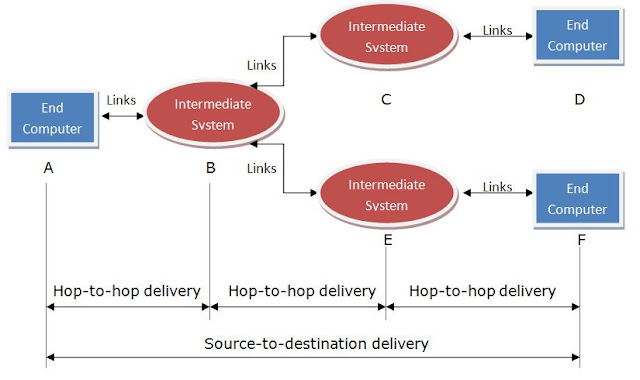It seems now we know What is a Network, What is Internetand How does it work. However their working principle is based on several task functionalities, and those tasks are distributed among certain layers in the architecture of the network. These layers form a model which is strictly followed to establish any network or a network connection.
There are mainly two model hierarchies which are followed, such as
1. OSI Model and 2. TCP/IP Model
OSI Model
OSI model stands for Open System Interconnection. An open system is defined as a set of protocols that allows the communication of any two different systems regardless of their underlying fundamental architecture. These protocols have their own functions distributed in the layers of the architecture.
The purpose of OSI model is to show how two different systems can easily communicate without changing the logic of the underlying hardware and software.
Note:OSI model is not a protocol, but a model for understanding and designing flexible and robust network architectures.
Often OSI is confused with term ISO. ISO stands for International Standards Organization which is a global organization devoted to worldwide agreement on international standards.
Architecture of OSI Model
The OSI model is a layered framework to design any networking system that allows communication between all types of computer systems. It’s based on seven separate, but related layers. Each of the layers defines their particular functionalities for moving information across the network.
Lets see the picture,
 |
| OSI model |
The OSI model is the collection of seven ordered layers: Physical (layer 1), Data Link (layer 2), Network (layer 3), Transport (layer 4), Session (layer 5), Presentation (layer 6), and Application (layer 7).
In developing the model, the designers condensed the process of transmitting data to its most elementary level. The processes on each machine that communicate at a given specified layer are called peer-to-peer process (P2P). Communication between machines is consequently a peer-to-peer process using the protocols appropriate to a given layer.
In a P2P network, the "peers" are the computers which are connected to each other via the Internet. Files and data can be shared directly between computers on the network over the internet without the need of a central server. In another way, each computer on a P2Pnetwork becomes a file server as well as a client.
Note:In its simplest form, a P2P network is created when two or more computers are connected to share resources without going through a separate server or a computer.
Layers in OSI Model
1. Physical Layer: Physical layer is mainly concerned with the activities of individual stream of bits from node to the next. Here, activities mean movements from one layer to another layer via a physical transmission medium.
2. Data Link Layer: Data link layer is sometimes called as media access layer (Mac). It’s mainly responsible for the movements of the Frames from one node to the next. This layer divides the stream of bits into data units called frames. Physical addressing, flow control, error control are also done here.
Note:Data link layer is mainly responsible for hop-to-hop delivery (node-to-node delivery).
 |
| Data link layer |
As you can see in the picture, to send the data from A to F, three parts of deliveries are being made. First, the data link layer sends a frame from A to B (which is a router). Second, the layer sends anew frame to the data link layer at E. And finally, the layer sends another new frame to the data link layer at F.
Note:The frames which are substituted in between nodes have different values in their headers. The frame from A to B has B as the destination address and A as the source. Same goes for B to E and E to F.
3. Network Layer: The network layer responsible is for the delivery of individual data packets from a source host to a destination host. End-to-end delivery or sometimes source-to-destination delivery is done here.
 |
| Network layer |
4. Transport Layer: Transport layer is concerned for delivery of the entire message from process to another.
5. Session Layer: In the network Session Layer is known as dialog controller. Session Layer is mainly responsible for dialog control and synchronization. 1. Dialog Control: Session layer allows two computers to enter into a dialog so that the process of the computers can communicate in either in half-duplex or in full-duplex. 2. Synchronization: Synchronization over here means, the processes in the session layer can add checkpoints or synchronization pointsso that streams of data can synchronize. 6. Presentation Layer: Presentation layer is mainly concerned with the syntax and semantics of the data exchanged between two computers. Presentation layer is responsible for encryption, compression, and translation of streams of data exchanged between computers. 7. Application Layer: Application layer provides the service to user for accessing the network. A software version of physical terminal is used in this layer known as network virtual terminal. Mailing services, file transfer, access and management are done here. STUDY SESSIONS Q1. How OSI and ISO are related to each other? Q2. What is the difference between Host-to-host delivery and Process-to-process delivery? Q3. What is a P2P process? Explain. Q4. Whats are the responsibilities of Network Layer and Session Layer? PLEASE USE THE COMMENT SECTION FOR ANY DOUBTS AND QUARIES. |



0 Comments